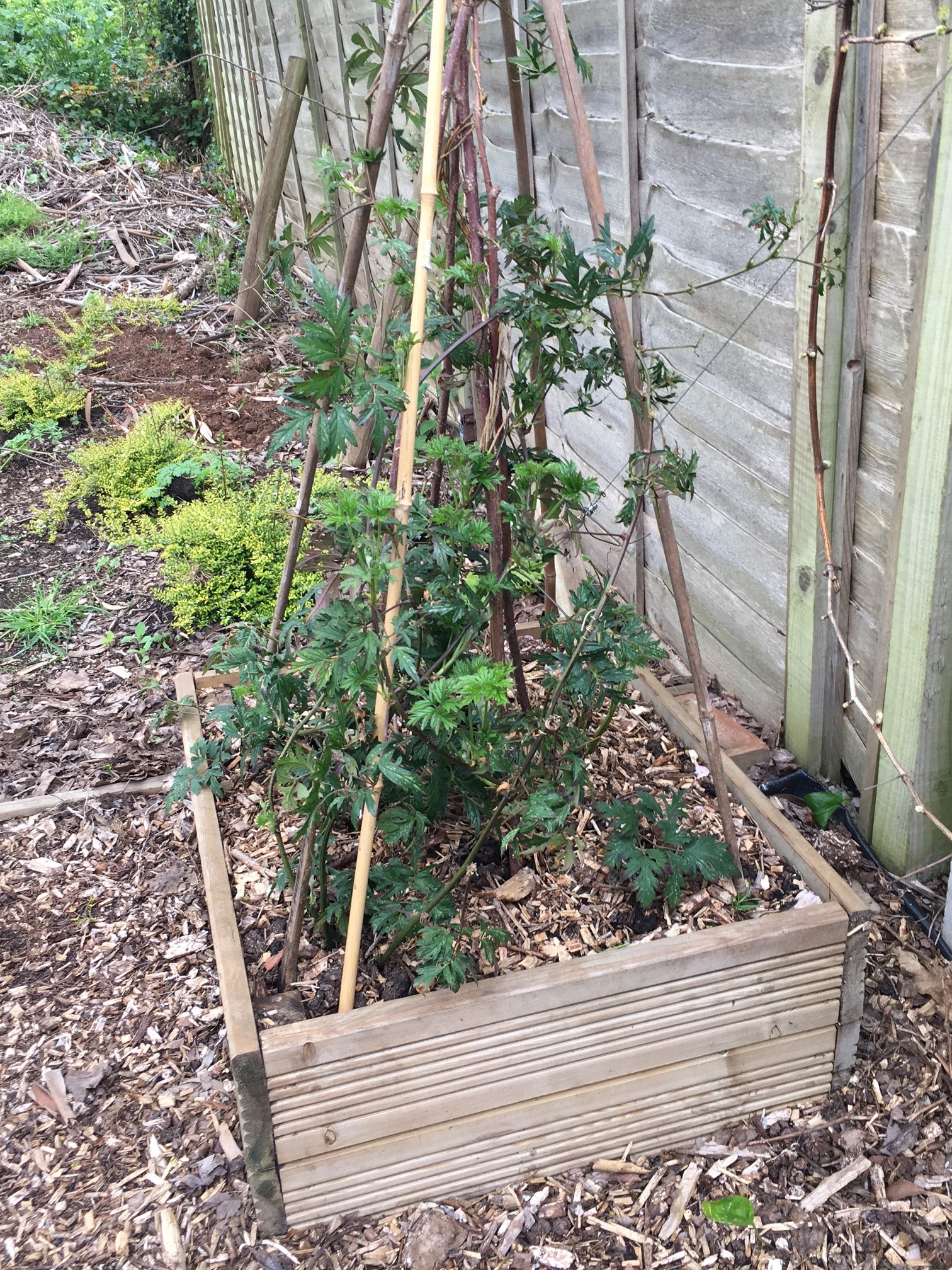

Thanks to Dylan Cheshire, Horticultural Manager at WESC for sharing this helpful guide on laying out your garden!
The WESC Foundation is a specialist day and residential centre in Devon offering a unique experience for young people and adults with visual impairment including complex needs. Their Discovery Garden is an onsite outdoor facility for the students to use and enjoy at the centre. Dylan Cheshire manages the garden and shares his tips here for setting up your own.
Edges to identify paths, prickly plants and other pointy things
We want everyone at WESC Foundation to be able to stay safe whilst exploring our Discovery Garden. You can use some of these tips at home in your garden:
Edging
You can use a range of different types of edging to mark out the sides of paths or different growing zones.
We use a mixture of hard edges like thick branches (simply laid end to end), and softer edges like lavender or grasses. The plants have different sensory interest like touch or smell.
Using edges can also help identify certain types of plants before you reach them. We’ve screwed pieces of decking boards together to build boxes around the base of some of our fruit plants like gooseberries and raspberries.

Image description: Image shows a raised cube wooden bed
with a plant and bamboo canes encasing it like a pyramid.
Cane toppers
Lots of us use bamboo cane in our gardens to support plants as they grow. Try using an old metal can (make sure you check it for sharp edges first) to sit on top of a bamboo cane.
This can also double up as a sensory label (see below) by gluing on some of your own materials like dried pulses or natural materials that you’ve foraged from the garden.

Image description: A cane sitting within a plant bed with an up-turned can on its top.
Sensory “labelling” for beds and planters
Why not make simple tactile mosaics to help label your different growing areas? See what you can find around the garden – anything from moss and bark to wood, stones and shells – and glue it onto a board.

Image description: Tactile label made from a raised pottery relief
with an image of grapes and leaves on a yellow circular background.
Another idea is to use sensory plants for different parts of your garden. At WESC Foundation we have lemon verbena and a beautiful yellow wallflower at the main entrance to the produce polytunnel. The lemon verbena’s strong-scented leaves usually drop around the same time that the wallflower comes into flower, so there’s always something to reach out for when our young people arrive for horticulture sessions.

Image description: The bright yellow and orange flowers.
Labelling your handles
There are lots of different bits and pieces around our Discovery Garden, including all sorts of garden tools, gadgets and buildings like our sheds and greenhouse.
We’ve used bright yellow on the handles of everything from trowels and spades to greenhouse doors and wheelbarrows. It can help create contrast so it’s easier to find the thing you need to grab, push, pull or open.

Image description: Dark-green watering can with its handle painted bright yellow.
What to grow?
Salads and leaves
At the moment we’re planting lots of salad leaves including lettuces and rocket. These grow really quickly, so you can reach out and feel the progress each week as they grow in height. We also plant these in several batches so that once our students have picked (and eaten!) a crop, there’s another on the way.
One of the great things about growing leaves is that they’ll grow quite close together, so you don’t need to be too accurate with how you space out the seeds when you’re sowing.
Vegetables
Our students love to grow their own food, because they get to harvest it and then take it off to the kitchens to practise their cookery. It might be a great way of introducing VICTA families to the world of grow-your-own.
Onions, garlic and shallots are great because the larger bulbs are easier to handle.
Working with seeds and bulbs
Sowing seeds into a ‘drill’
- Cut a length of bamboo cane so it fits across the soil in your garden, planter or raised bed.
- Get your hands dirty in the soil to smooth it out and check for things like stones
- Give the cane a little wiggle. This will make a shallow, straight channel (called a drill) in the soil.
- Move the cane to the edge of the drill. You’ve now got a straight guide line to use as a tactile guide to sow your seeds in a straight line.
Pro tip: if you want to sow in neat little rows, you can use a garden tool as a tactile rough guide to help your spacing. We use a small hand trowel!

Image description: Using a cane as a guide to plant seeds in a straight line.
Making a pocket with a trowel
- Push a small hand trowel into the soil
- Wiggle it from side to side to create a small pocket in the soil.
- Leave the trowel sticking out of the soil! You can then use it as a guide to find the hole when it’s time to plant the seeds.
- Once you’ve planted the seed you can reach out, remove the trowel and gently smooth the soil back over.
Growing in module trays
These plastic trays are easy to fill with compost, and give you lots of small spaces (modules) that you can feel with your hands. We use them for single seeds or even small bulbs, and just brush the excess compost off when we’ve planted things like plug plants or onion sets.
Once you can feel that the roots are reaching the edges you just pop out the bulb (together with it’s surrounding compost) into your hand, and it’s ready to plan in the soil.

Image description: Onion bulbs growing in a modular plastic tray.
Where to start
Many of the young people at WESC Foundation have additional needs as well as a vision impairment. This means that we often start off by working with robust plants and vegetables (like broad beans) that are easy to handle.
You can also use larger flowering bulbs too. These are good because you can explore the surface of your bulb with your hands to find the flatter end that goes into the soil first.
More garden fun
Our gardens aren’t just for planting flowers, trees and plants. Lots of insects and other bugs love to make their home in our gardens and outside spaces.
You can try a fun activity like building a bug box. Ours is a huge one that our students built together in the Discovery Garden at WESC Foundation, but you can build something a bit smaller at home.

Image description: Bug hotel made from piles of logs, wood, straw and wool.
- Start off with a large, deep plant pot (a solid, terracotta one might be best if you’re planning on filling it with lots of materials for your bugs)
- Gather together old hollow garden canes, together with sticks and branches from trees and bushes in your garden (with any twigs etc cut off), pine cones and a bit of stuffing like shredded paper or garden lambswool.
- Stand your old hollow garden canes upright in the pot, along with the pine cones and anything else that could be shaped into a hollow (like rolled-up tree bark)
- Pack the moss and all your remaining foraged bits and pieces into the pot around the canes and everything you’ve added in step 3.
- Lay the pot on it’s side in the garden and wait for the bugs to arrive!
Find out more about WESC
WESC Foundation is a charity in the South West UK that supports children and young people who have vision impairment and complex needs. The charity runs a school and specialist college for day and residential pupils (up to 25 years old). We also have Supported Living accommodation at the edge of Exeter, a registered residential care home for young adults who have finished education, and a day centre for adults. Our main site has a range of facilities including therapy suites, swimming and hydrotherapy pools, and the Discovery Garden horticulture project.
Visit the WESC website to find out more: www.wescfoundation.ac.uk
If you use any of these tips let us know and tag us on social media @VICTAUK and @WESCFoundationExeter.











Leave A Comment